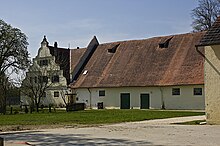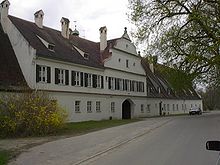Pipe field
|
Pipe field
Large district town of Neuburg on the Danube
Coordinates: 48 ° 43 ′ 35 " N , 11 ° 16 ′ 25" E
|
|
|---|---|
| Height : | 378 m above sea level NN |
| Residents : | 29 (Dec. 31, 2019) |
| Postal code : | 86633 |
| Area code : | 08431 |
Rohrenfeld is a district of the large district town of Neuburg an der Donau in Bavaria , which is about 7.5 kilometers east of the city center.
Rohrenfeld was originally an agricultural stud and has been owned by the Wittelsbach Compensation Fund since 1923 .
Together with Maxweiler and Rothheim, Rohrenfeld is in the district of Bruck.
history
Until the middle of the 15th century Rohrenfeld stood as a Schwaige . In 1487, Duke Georg von Bayern bought the "farm", on which there were cows, sheep, goats , goats and buffalo. Even Ottheinrich , the Count Palatine of the Duchy of Palatinate-Neuburg , liked to stay here and often hunted down big stags. During his reign , the stud provided important food such as butter, lard and eggs for the prince , but also for the hospital in Neuburg .
The duke started breeding horses here in 1560 . As early as 1571, 41 horses, including 13 broodmares, and 63 beef cattle, including 13 milking cows, were registered in the Schwaige. From 1571 to 1699 the stud comprised 464½ old days of real estate, which would be 232.25 hectares according to today's dimensions. A cost estimate from 1619 shows that wheat, rye, barley and oats were grown as crops.
In 1722 the stud was leased for the first time, for 9 years to the stud manager Carl Satori. But already early in 1727 there was again an electoral administrator. And in 1741 the whole thing was leased again. The stud was continuously enlarged and in 1799 already had 568 daily work meadows and 78 daily work fields, but without grazing rights. The lordly forests of the city of Neuburg with 1235 days of daily work, as well as 428 days of forest of the municipality of Bergheim were designated for pasture use at that time. Now plots of land were constantly being exchanged and bought.
Originally the estate belonged to the municipality of Bruck , but was reclassified to the municipality of Zell in 1948 . During the territorial reform , the stud and the municipality of Zell became part of the city of Neuburg on January 1, 1976.
The wars and the raid
The Swedes also discovered the stud in 1632, even the King of Sweden Gustav Adolf stayed here. The Swedes made their raids and captured all useful horses. In 1634 the Swedes came again, burned the estate and stole the horses again. In 1644 the homestead was finally restored. In 1669 the estate was rebuilt and turned into a stud.
During the Napoleonic Wars , Rohrenfeld was crossed several times. The French came in 1796: 79 broodmares, 5 mule mares, 1 donkey mare, 24 three-year-old colts, 18 two-year-old and 4 one-year-old foals, a total of 101 were prey for the raid. In addition, 12 three-year-old horses were given away to French generals. During the campaigns in 1800 there was another foray, but this time the damage was limited.
The court stud
In 1671 79 old and young horses could be recorded and it was again the court stud of the Palatinate-Neuburgian dukes. A flourishing horse breeding developed, in 1698 114 horses neighed and from 1740 mules were still bred. Rohrenfeld was the supplier for the princely stables in Neuburg.
In 1752, Elector Karl Theodor had the buildings rebuilt again. A riding school has now been attached. The stud was in full bloom. In 1796 377 horses were already trotting here. Despite all the warlike events, the stables were soon bursting at the seams, the builders had to toil again, expanded the stables and built the wing on the north side. There were only two studs of this reputation in Bavaria, this was the Ryß stud near Salzburg and Rohrenfeld. Gut Rohrenfeld was also an important employer, in some cases up to a hundred people made a living.
The horses have always shaped the life of the stud. During the Second World War , the stud got the function of a "home horse park". It was, so to speak, the hospital for injured horses, which were healed here and then had to do military service again. Horse breeding continued to be a dominant feature of the estate. Horse breeding was not excluded until the goods manager Johannes Heinrich died at the end of 1984. The farm now only had an agricultural function.
A royal quarter
The Rohrenfeld stud farm has always been a popular place to stay for kings and princes. Count Palatine Ottheinrich already enjoyed the lush green Danube floodplains, the mighty oaks and the oxbow lakes. He enjoyed being the master of the hunt here. In 1632, during the Thirty Years' War, the Swedish King Gustav Adolf stayed here and visited the area. The Neuburg Princess Maria Anna , wife of Carl II. , Of Spain was interested in the plans for the stables at Gut Rohrenfeld and asked for cows, oxen and calves from the stud. On July 9, 1894, a special train steamed to Rohrenfeld, the guests were His Royal Highness, Prince Regent Luitpold of Bavaria , accompanied by personalities. They visited the court stud. For this purpose, a race track was built and racehorses galloped on it. For King Ludwig III. (1845–1921) it was the favorite stud. Crown Prince Rupprecht of Bavaria also stayed here once or twice a year.
The religious life on the stud
The residents of the royal court stud have always belonged to the parish of Weichering . The walk to the parish church would have been a good four kilometers . But the believers were spared this journey. The estate administration provided a prayer room for church events , and the pastor was picked up and brought back by carriage from the rectory on Sundays and public holidays . The estate paid the clergyman 124 guilders a year for church care ; in 1818 the amount was increased to 300 guilders.
The stud was concerned about the salvation of the residents and in 1827 built a chapel for “Holy Communion ”. The altarpiece , an oil painting on canvas , depicts Christ in Emmaus . There is also a copy of the Mother of God von Altötting and a painting of the "Holy Family Joachim and Anna ". In the church archive of Rohrenfeld, 22 souls are recorded for 1861 including the service staff. The later files from 1891 show that the clergyman is paid 500 marks annually from the stud fund for his services. Pastor Thuma did not enrich himself with the tinkling coin, but taxed this income and donated the rest to good causes, explained his successor, Pastor Trey.
On July 17, 1914, the royal court stud applied to the diocese of Augsburg for re- parsing to Zell, as the way and the road conditions were more favorable for the children. The new pastor, Pastor Trey, vehemently opposed the outsourcing of Rohrenfeld, but despite all objections he had to give in. On March 2, 1916, the State Ministry issued the permit. Since then, the parish of Zell has looked after the faithful. The clergyman was picked up in Zell by carriage for church services.
Golf course and golf club
In 1986 golf architect Mag. Joan Dudok van Heel designed an 18-hole golf course for Gut Rohrenfeld from 67 hectares of agricultural land . The architect was a former internationally successful golf amateur and multiple Dutch master. The builder and owner is the Wittelsbacher compensation fund in Munich. In 1991 the German Golf Association (DGV) organized the “Audi International Amateur Championships of Germany” on this golf course.
The Wittelsbacher Golfclub Rohrenfeld-Neuburg e. V. was founded in 1988 and HRH Herzog Max in Bavaria acted as president .
The clubhouse was designed by architect Max Graf Waldburg-Wolfegg. It was also set up according to his plans. The restaurant with its 80 seats can be expanded to 160.
In 2009 the operating Wittelsbacher Golf Club was awarded the contract to compete as a national applicant for the 2018 Ryder Cup . In the course of this application, it is planned to expand the golf course on an area of 165 hectares with a further 18-hole golf course, a practice facility and a 6-hole short course .
swell
- Ludwig Wagner: Chronicle of Zell Bruck - with Marienheim, Rödenhof, Rohrenfeld and Maxweiler - on the trail of village history . Self-published, Neuburg 1998, 416 pp.
- Brochure from the Wittelsbacher Golfclub Rohrenfeld-Neuburg, date probably 1991.
Individual evidence
- ^ Population figures in the city of Neuburg an der Donau
- ^ Federal Statistical Office (ed.): Historical municipality directory for the Federal Republic of Germany. Name, border and key number changes in municipalities, counties and administrative districts from May 27, 1970 to December 31, 1982 . W. Kohlhammer GmbH, Stuttgart and Mainz 1983, ISBN 3-17-003263-1 , p. 601 .
- ↑ Press release from the Wittelsbacher compensation fund golf course-Verwaltungs-GmbH ( page can no longer be accessed , search in web archives ) Info: The link was automatically marked as defective. Please check the link according to the instructions and then remove this notice. (PDF file; 230 kB)
- ^ Hofgut Rohrenfeld, German Ryder Cup candidate. Weserkurier from December 8, 2009






